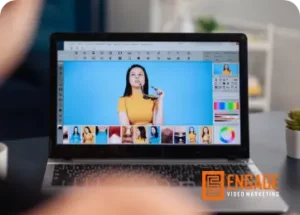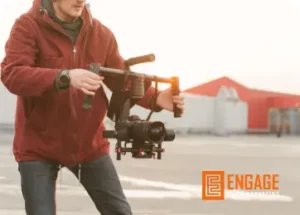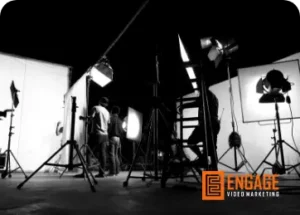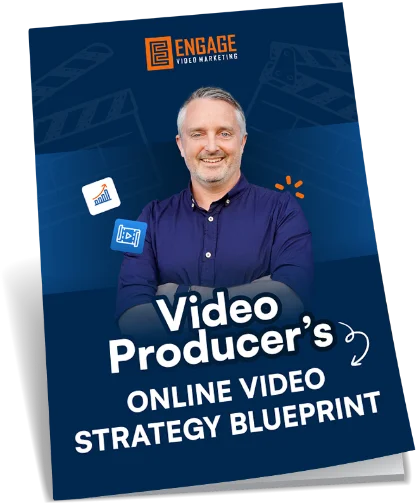Storytelling, it can be a bit of a buzzword when it comes to marketing, but when it comes to video marketing, telling a brand story in the right way is a very powerful tool to have in your toolkit. So in this article, I’m going to share with you seven stages to a compelling brand story video to help you next time, you’re using story in your video marketing.
In his awesome book, Building a Story Brand author, Donald Miller says that story creates music from noise. When it comes to marketing, I’m sure you recognise that it’s a very noisy place. So if you’re going to be investing time and effort into creating video content for your business, then you need to be thinking about how you can craft that video content in a way that engages your ideal audience and compels them to take action. Brand storytelling is a very powerful way to do this using video, but the problem is that so many people are approaching their brand storytelling the wrong way.
So over the next few minutes, I’m going to share with you seven stages that you need to consider when you’re crafting a brand story video for your business and stick around to the end, because I’ve got a bonus tip to share with you, that’s going to bring all of these concepts together and make it actionable for you.
Let me just run through them, the seven stages for compelling brand story video:
- Our hook
- Pain,
- Desire
- Guide
- Transformation
- Result, and
- Action
And of course, I’m going to break each one of these down in more detail as we go into the training here today. But I want you to recognise that before we get into it, that you are not the hero of your story. Okay? There’s a really good book here. It’s actually on the shelf here behind me. It’s called Building a StoryBrand by Donald Miller. Now, if you haven’t picked up this book yet, I strongly recommend that you grab a copy of building a StoryBrand by Donald Miller or follow the teachings of Donald Miller. And StoryBrand is now called Business Made Simple. If you dive into that, you’ll realise that he focuses a lot on what we’re going to talk about here today, as well around the power of telling and using storytelling as a foundation in your marketing. And a lot of that aligns of what we’re going to talk about here today as well.
The important thing to recognise is that your hero, the hero of your brand story is your customer, your client, your customer. And at the end of the day, you need to play, your business needs to play the role of the guide that comes alongside and helps your customer achieve an outcome in their life. And that’s critical here. So as we go through these seven stages, I want you to keep that in the back of your mind.
#1 Emotive HOOK
So let’s talk about this first stage and we start by hooking the viewer – hooking your ideal audience. And this is just the foundation of good video marketing in general. But if we don’t hook the viewer and can capture their attention right at the beginning, then we’ve lost them. Okay? So, we could be telling the most compelling story after that point, but if we haven’t got them watching and we can’t keep them watching, then we’ve wasted our opportunity.
So what you need to do with the hook of your brand story video is grab the audience emotionally – a clear emotional message. Because a brand story video is designed to connect on an emotional level with your ideal customers or clients it’s designed to get them to buy in. Before you ask them to buy other types of content within your video marketing strategy can do the job of conversion or selling. But when we’re telling a story, we’re hitting on the emotional triggers, that’s going to get people to buy in, which is that a heart-centered emotional stage of the marketing journey that you’re going on. So what we want to do in this emotive hook section is really grab the audience’s attention and then hold it through, including something that they really care about, something that affects them in their life right now. So you really need to understand your audience and I’ve done other videos on my YouTube channel, where you can go into greater detail around understanding your audience, but the hook here needs to hook emotionally on something that they care about – your ideal audience cares about. This can be a visual hook. Starting with compelling visuals that really capture the attention of your ideal customer or audience and draws them into this story. Or it can be text on the screen can work really well, or in fact, just an oral hook as well. So the words, the opening words of the story, or the opening sound bite from the interview that is kind of forming the basis of your brand story. If you can craft those opening seconds really deliberately, then you’re off to the right steps. You’re off to the right start when it comes to a compelling brand story.
You want to include here in this hook section some kind of subtle brand elements here as well, whether it be, you know, a logo in some way, but not like just an animated logo that slaps you in the face, but includes some kind of subtle brand elements here so that you can get that early brand impression, which is important as well. But importantly, that branding shouldn’t detract from the story elements. The goal here is primarily to get people into the story.
#2 Establish PAIN
Once we’ve established the hook that now we need to establish the pain, okay. Because at the end of the day, a story starts with the character, the hero character at some kind of emotional unbalanced. So, there’s some kind of pain. There’s something lacking in that hero customer’s life that your brand, your business can solve. So we need to very early on establish the pain that your hero customer is probably feeling in their day-to-day life, around your business, your product, or your service, again in particular, where they are before they’ve bought your product or used your service. It must be relatable and relevant to the audience here. So the way that you incorporate and establish the pain here, as someone watching it, your ideal customer watching it needs to go, “They get me.” “I understand that they understand me, they know what I’m feeling.”
So whether you’re, it’s the part of the interview that you’re including right at the beginning here in this introduction section of your story, or whether it’s something that the way that you craft your script, if it’s a scripted brand story video, either way you need to establish the pain and then emphasise through that, what is at stake if they don’t take action? So make it really clear that if you don’t deal with this pain, this is what’s going to happen.
#3 Set up DESIRE
Once we’ve established the pain, then we go through to the next stage of compelling brand story, which is setting out the desire. So here you need to set up that the hero customer wants to achieve something in their life. What is the desired outcome that if they take action and go on a journey, with your brand or your product or your service, then they’re going to hopefully ideally reach this desired outcome. This is where the story really sets in motion. You need to set up the positive outcomes that can be possibly reached when working with your brand or your business or your product. You want to allow the audience to really connect with that and want the same outcomes for themselves in their life. So it’s important here that the desire that you’re establishing really resonates with your ideal audience.
#4 Introduce the GUIDE (brand)
Once we’ve set up the desire, then we moved to stage four, which is introducing the guide. And this is where you make it really clear of the role that your brand or your business, actually plays in supporting the hero customer towards their desired outcome. This is where you introduce your brand or your business or your product and how they empowered the customer along that journey towards success.
Now, importantly, when I say how they empowered your customer along that journey, you need to show, not tell, mostly it’s about showing how your brand or your business actually works with your clients, with your hero customer clients. So this is through the visuals that you use or through what said within the interviews as well. This is where you want to communicate what it looks like to work with you. Make that obviously a positive representation of that experience. The focus here needs to remain on the customer’s transformation. But here you’re communicating that the brand is now alongside them, helping them towards that outcome. So once you’ve introduced the guide, which is your brand, the business, the product or service that you’re trying to market through this brand story video, then you need to actually show the transformation journey.
#5 Show TRANSFORMATION journey
As we’re watching this brand story video, the audience needs to understand the transformation that this customer has gone on or that your customers go on. So we need to be able to really understand where they were, the journey they’ve been on and now where they end up. So maybe it’s a step-by-step process. Maybe there’s a number of key moments within that process that you can exemplify in the footage or the B-roll or the shots that you include within your brand story video. You want to communicate that in a way that subtly, but clearly communicates the transformation journey and what that looks like.
#6 Highlight the RESULT (new normal)
Number six, here, we’re going to highlight the results, which is the new normal for your customers. The story needs a resolution, right? We need a climax. We need a resolution.
We understand that from high school narrative structure storytelling. And if you don’t highlight what the result is, what the resolution is, then you’re potentially leaving an open loop, which isn’t a satisfying story. So we need to clearly describe here in the brand story video, what the win is that you can potentially achieve in using this brand, this business, this product, or this service. You want to show that you want to somehow represent what success looks like through the visuals that you use, the footage that you get. You also, obviously where you can, you want to highlight that with the soundtrack as well. So maybe it’s a grab from an interview that actually says what their life is like now that they’ve had your product, they’ve used your service. So we want to highlight that new normal, that changed life, that your product or your business empowers in your hero customers.
#7 Call to ACTION
And then finally, number seven, a call to action. In any video marketing, we need to be clear what other next steps that we want someone to do now that they’ve engaged with this story. And importantly, here for a brand story, you want it to be a soft call to action. You don’t want to be hitting them around the head with a hard sell or a pitch. You want it to be an invitation to learn more or to find out more or to go and visit your website or to find out more information about how they can do business with you. You can either explicitly mention this, or you can include this in say closing, captions or words on the screen or text overlays and so on. Really, I think critically here, when it comes to the call to action is the goal of this kind of video is to move people further down the funnel towards buying from your brand or your business.
So assume here that certain people are going to watch this brand story video. And if they resonate with it, then they will quickly move down that journey to make a conversion or to buy from the business. But in many cases, it’s the first touch point. This brand story is the first touch point on a journey to go and buy from you or your business. So ensure that soft call to action that leads them in the right direction, not slaps them around the face with some kind of a sales pitch or pitching a product.
So there you have it, seven stages for compelling brand story, video, content, hook, pain, desire, guide, transformation, result, and action. Now I did promise you one bonus tip to bring this all together. And the fact is when you’re crafting a brand story video for a business, you want to be approaching the production process with a very open mind. So I recommend don’t try and go into the production process with this structure perfectly laid out. In fact, in many cases, it’s better to actually craft the story in the edit, go into production with a focus on what you want to unpack, what you want to achieve through the footage that you get and through the interviews that you conduct. But at the end of the day, crafting the story around the seven stages that I shared today needs to be put together in the edit process. And that is a skillset in and of itself.



